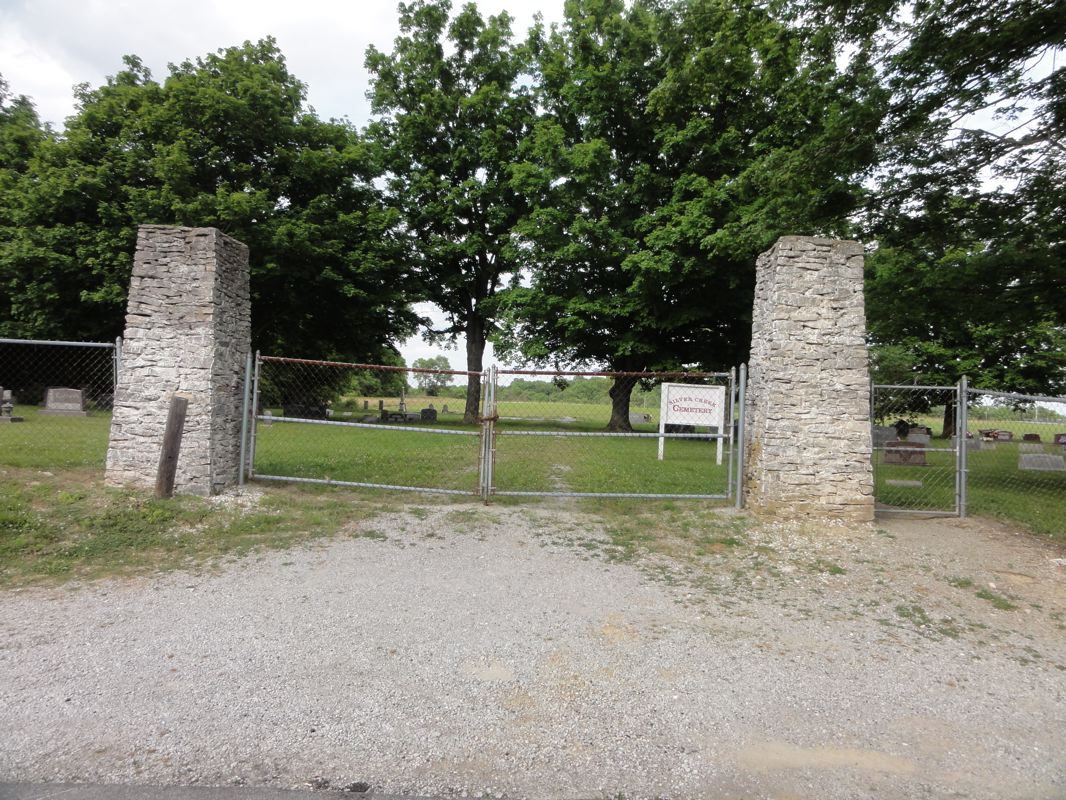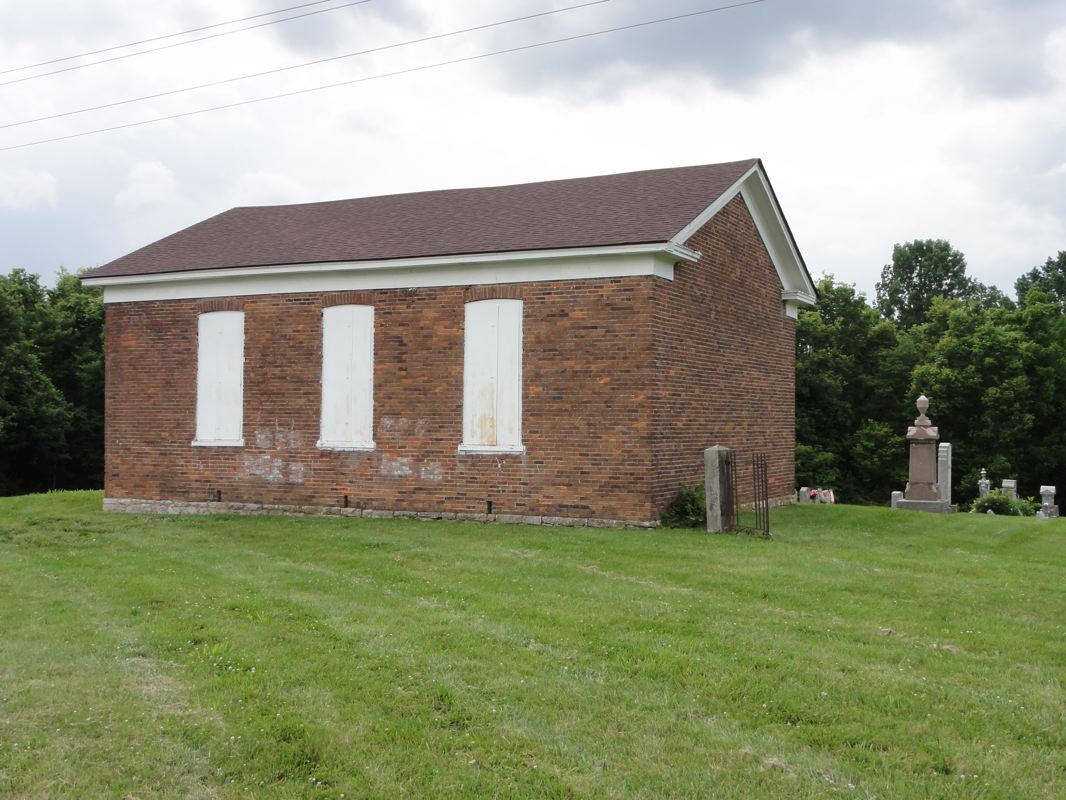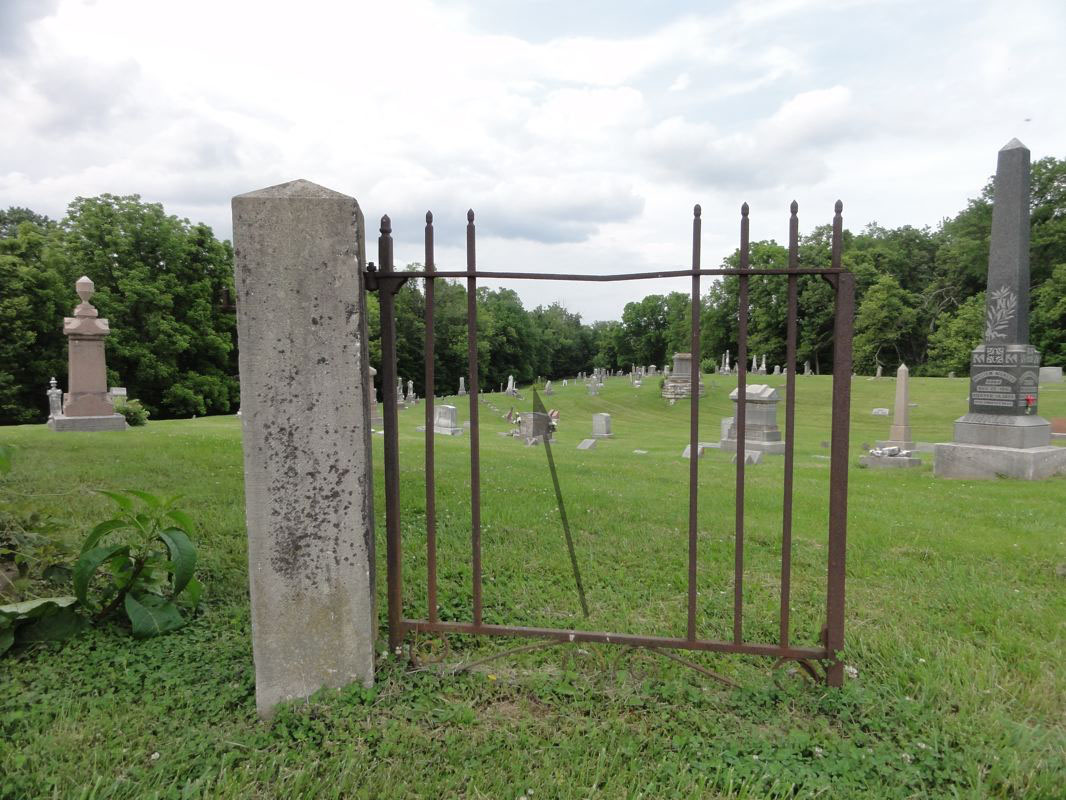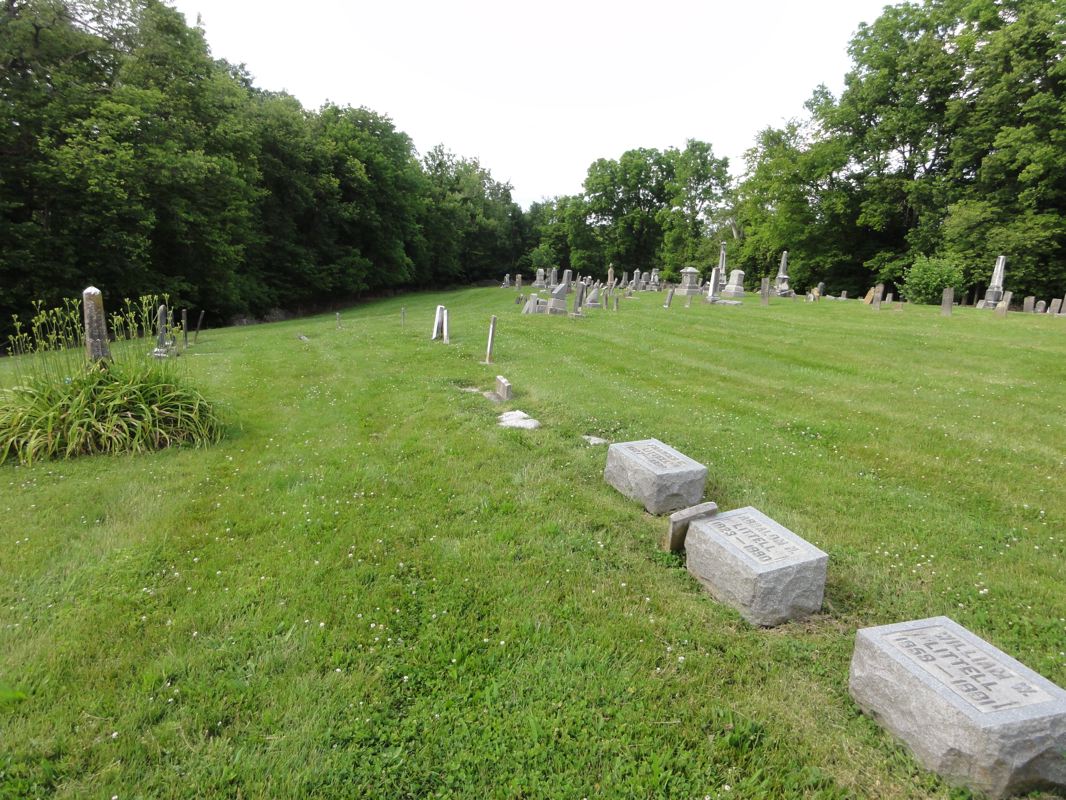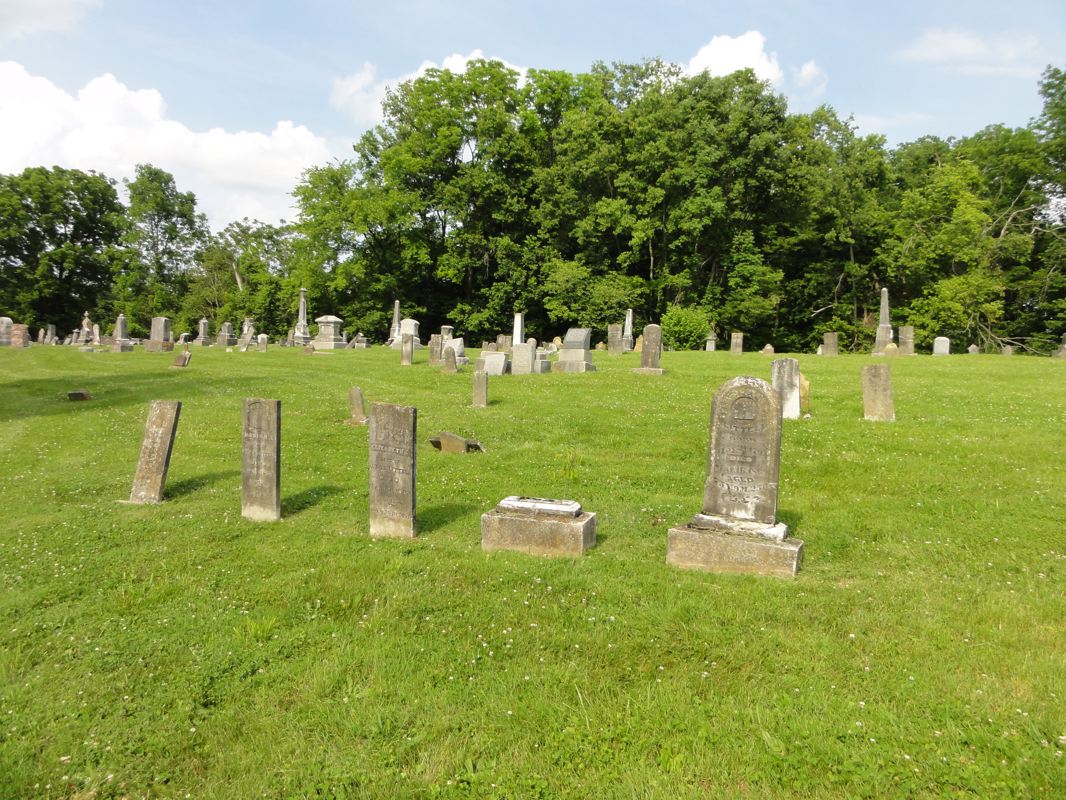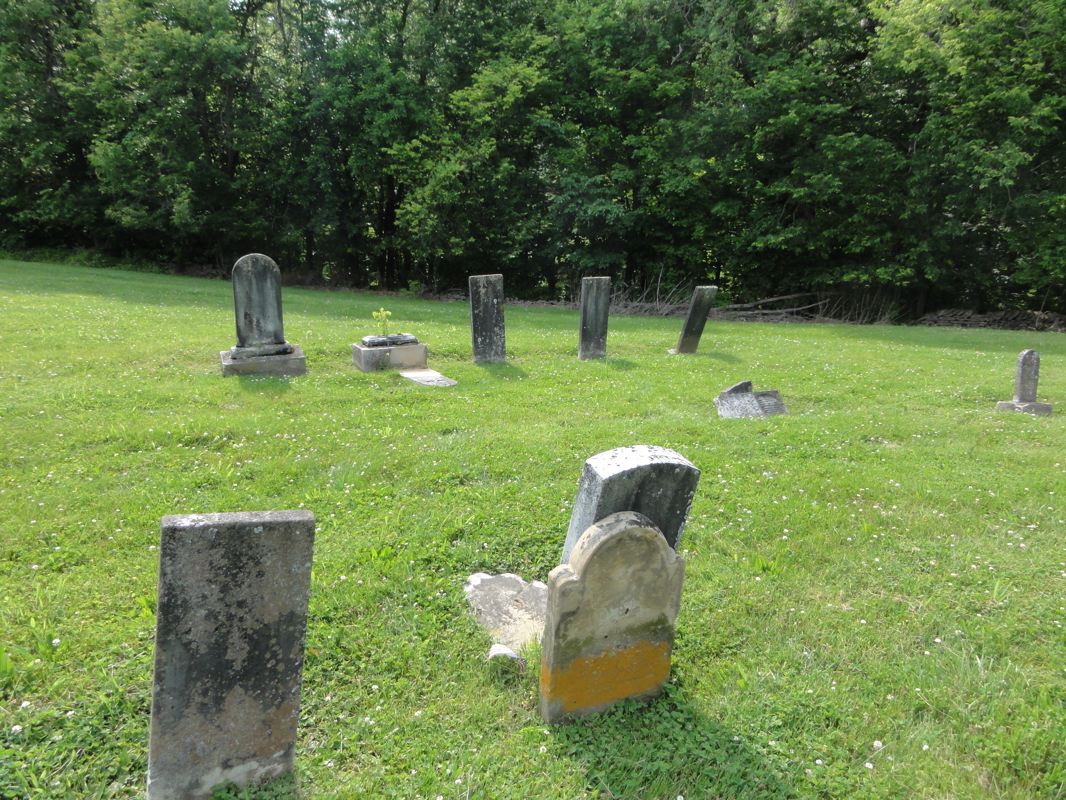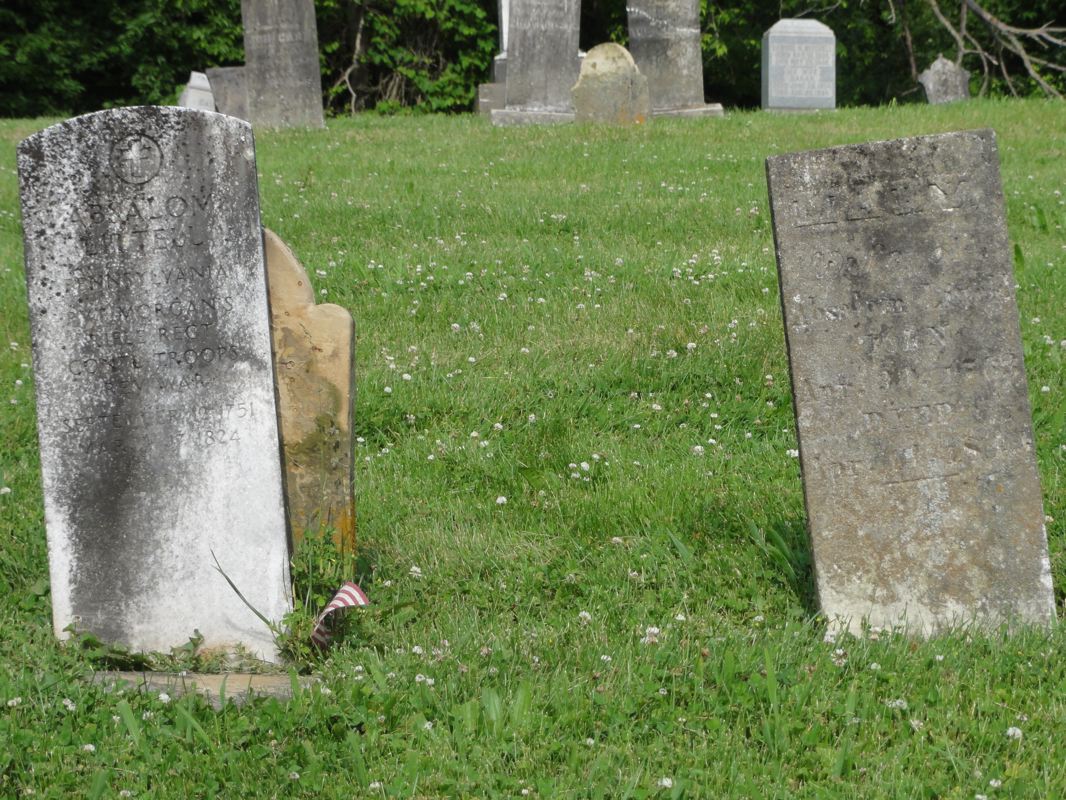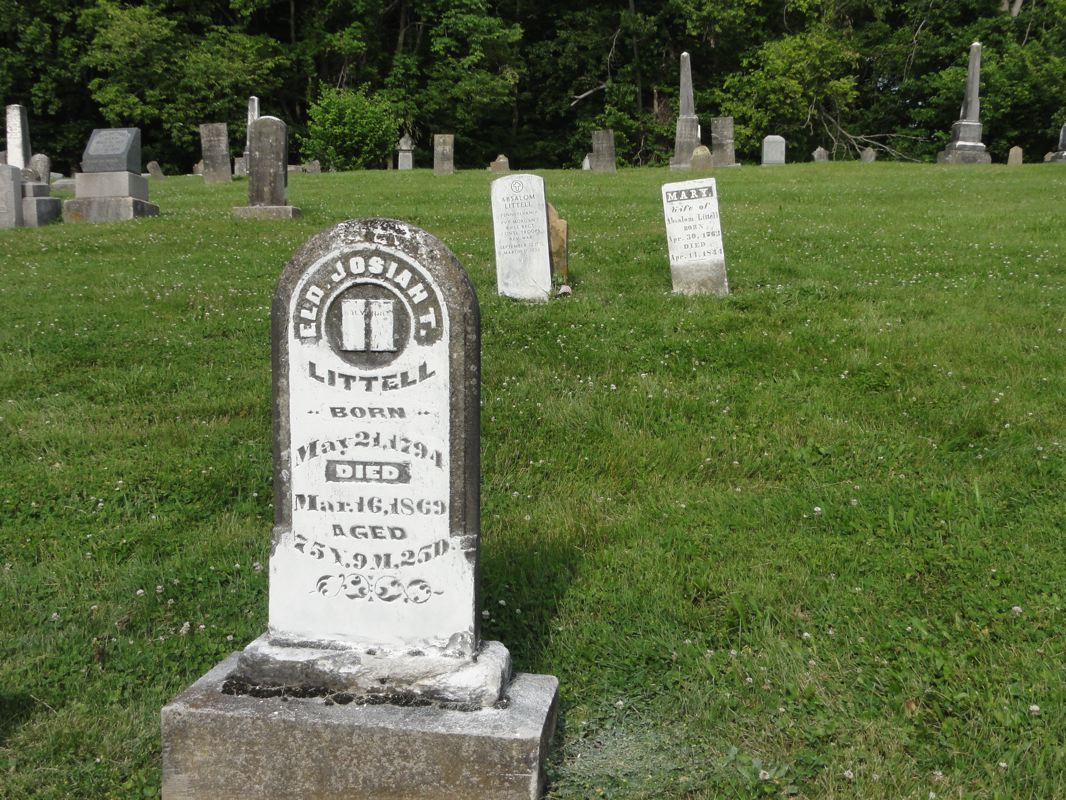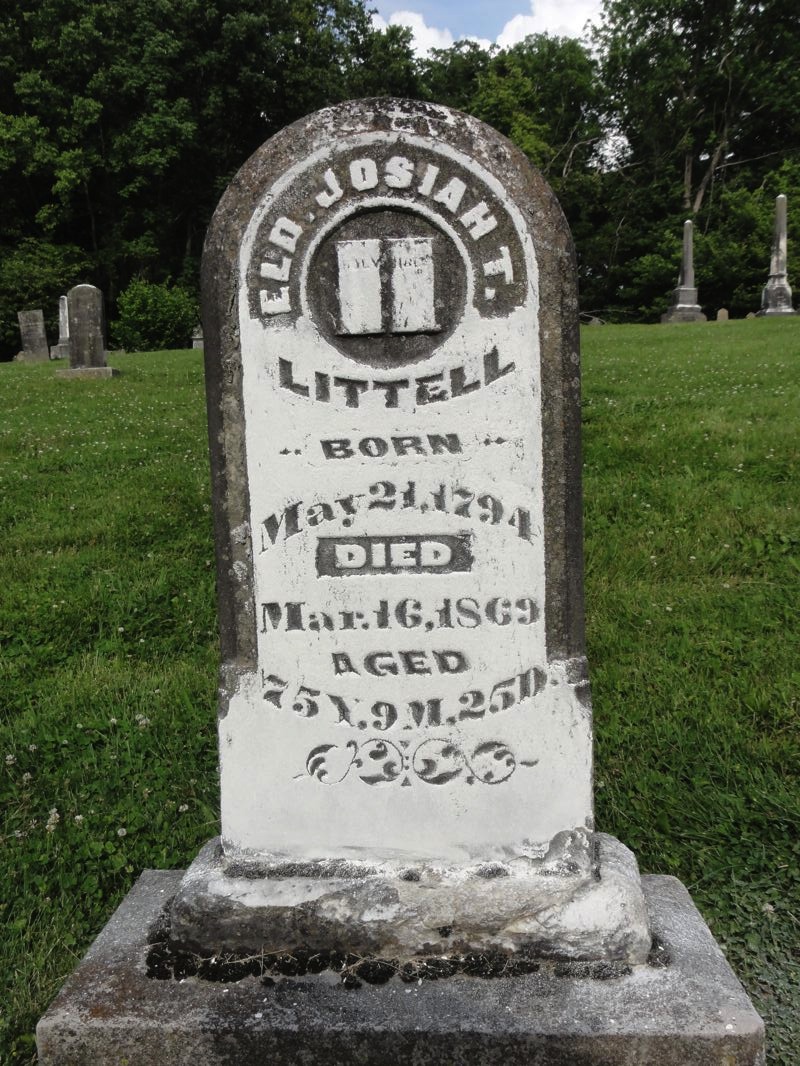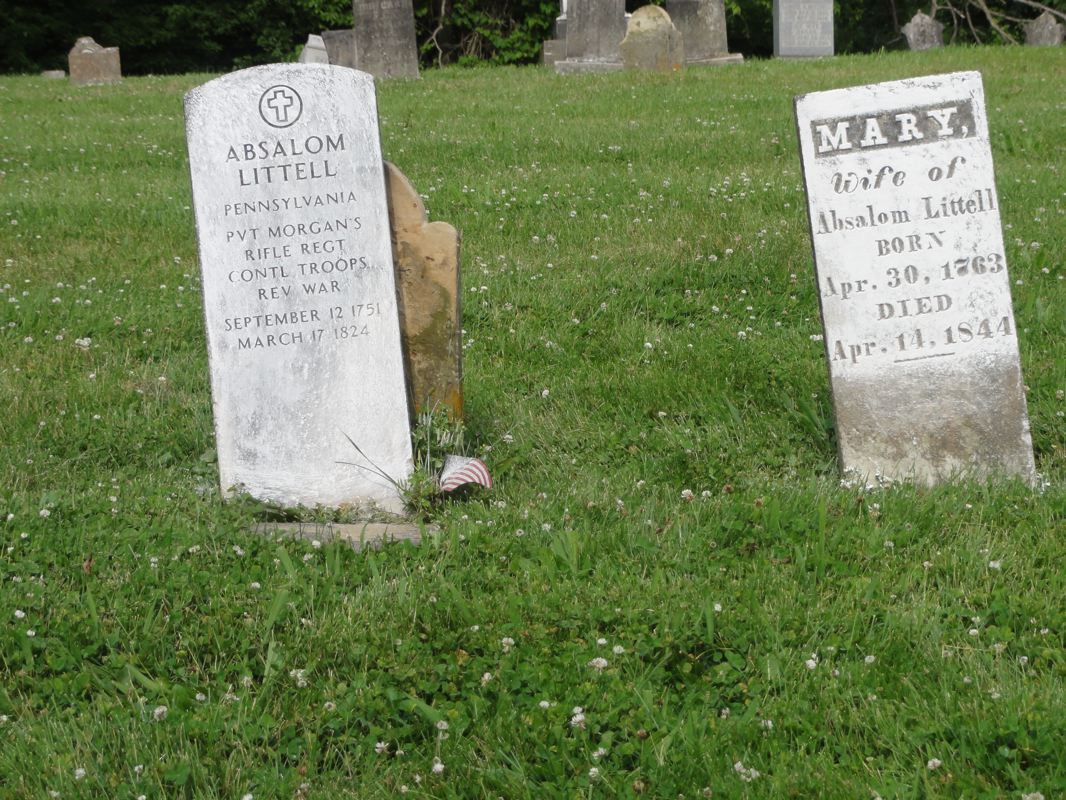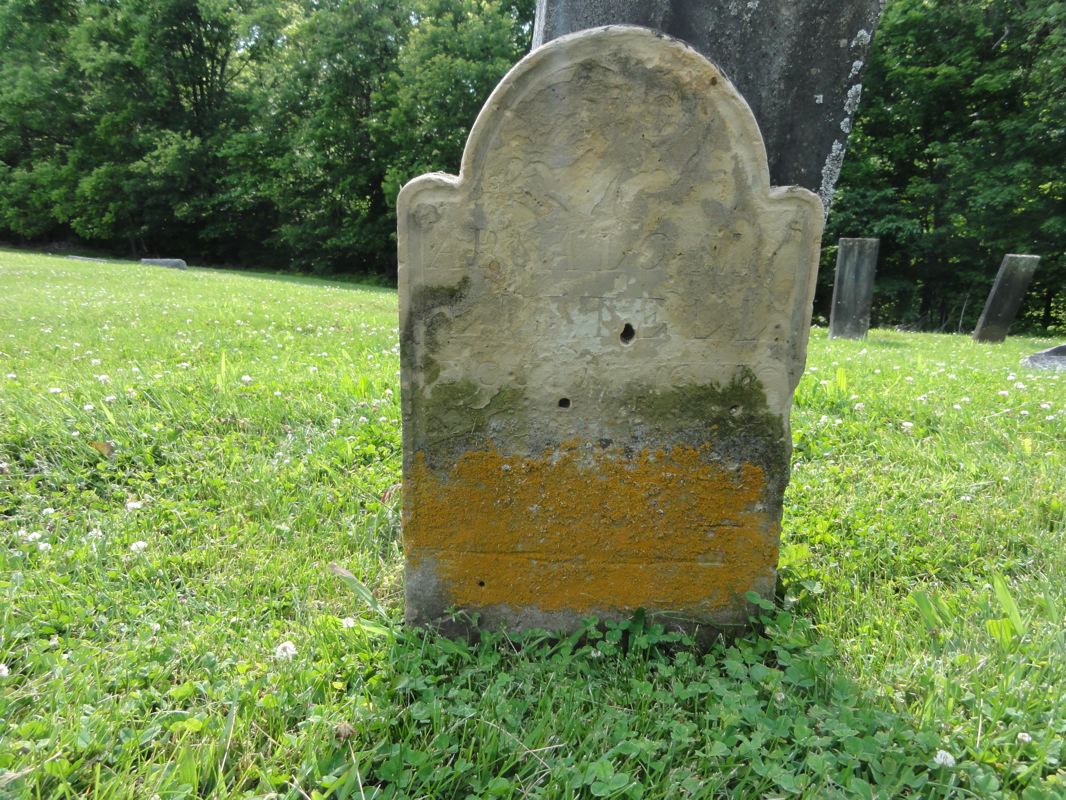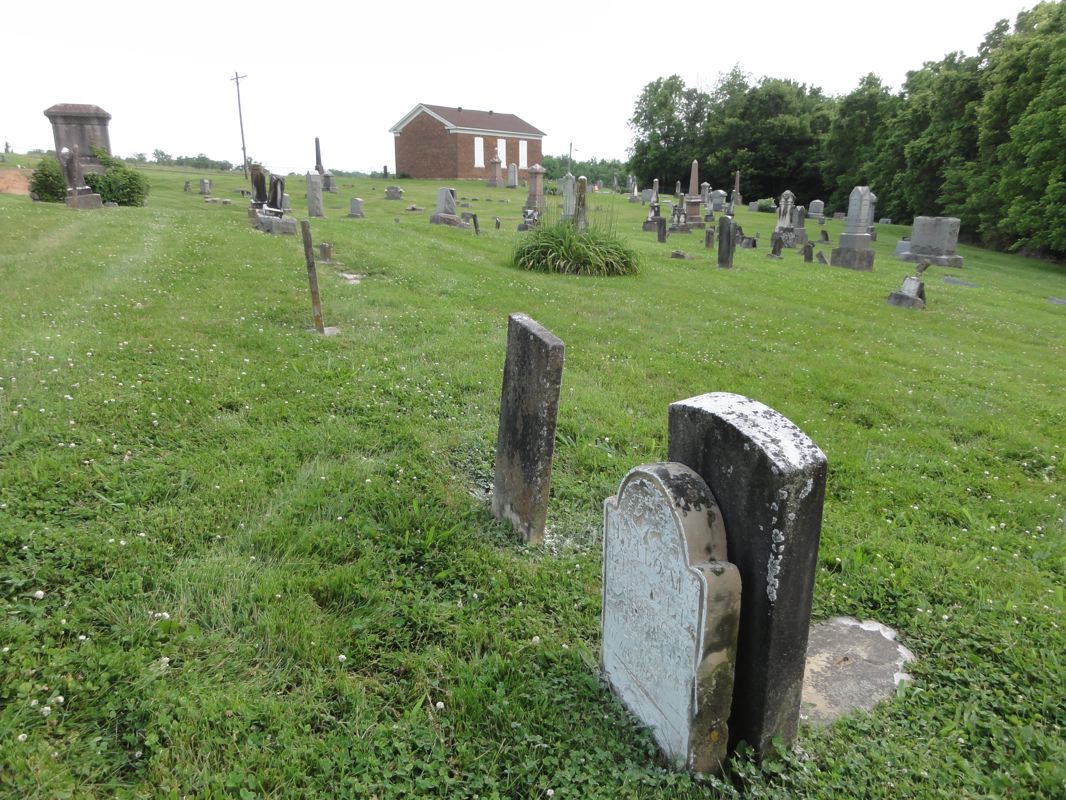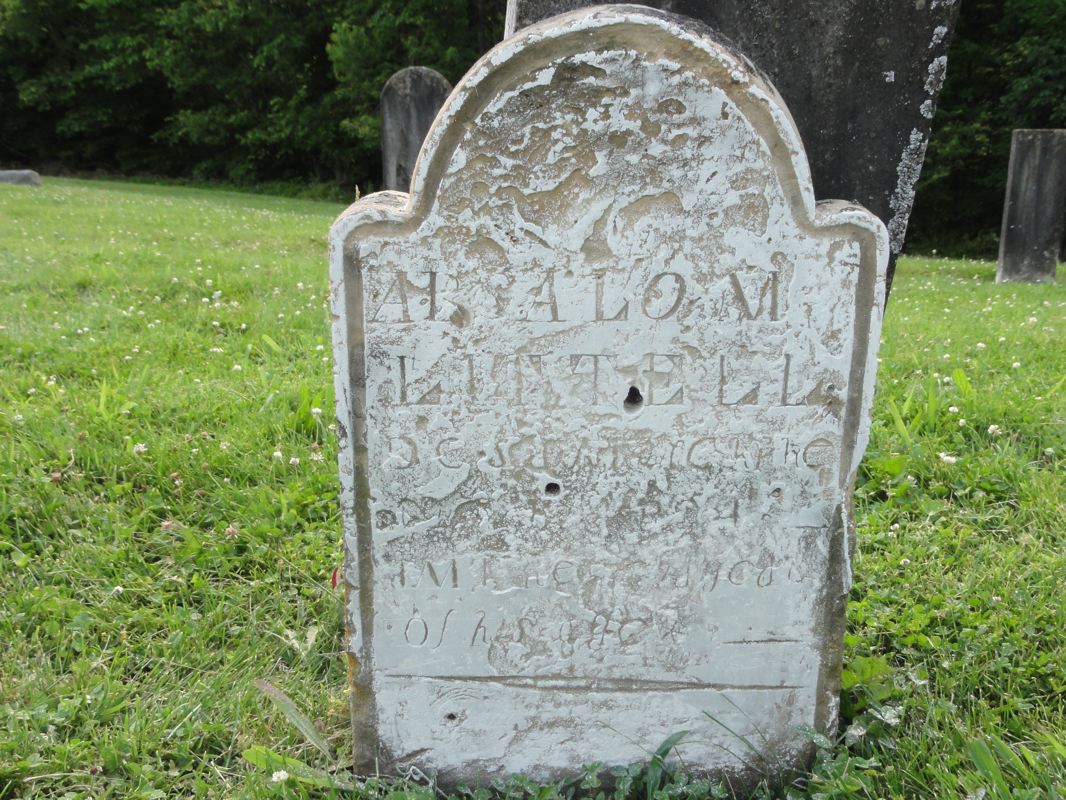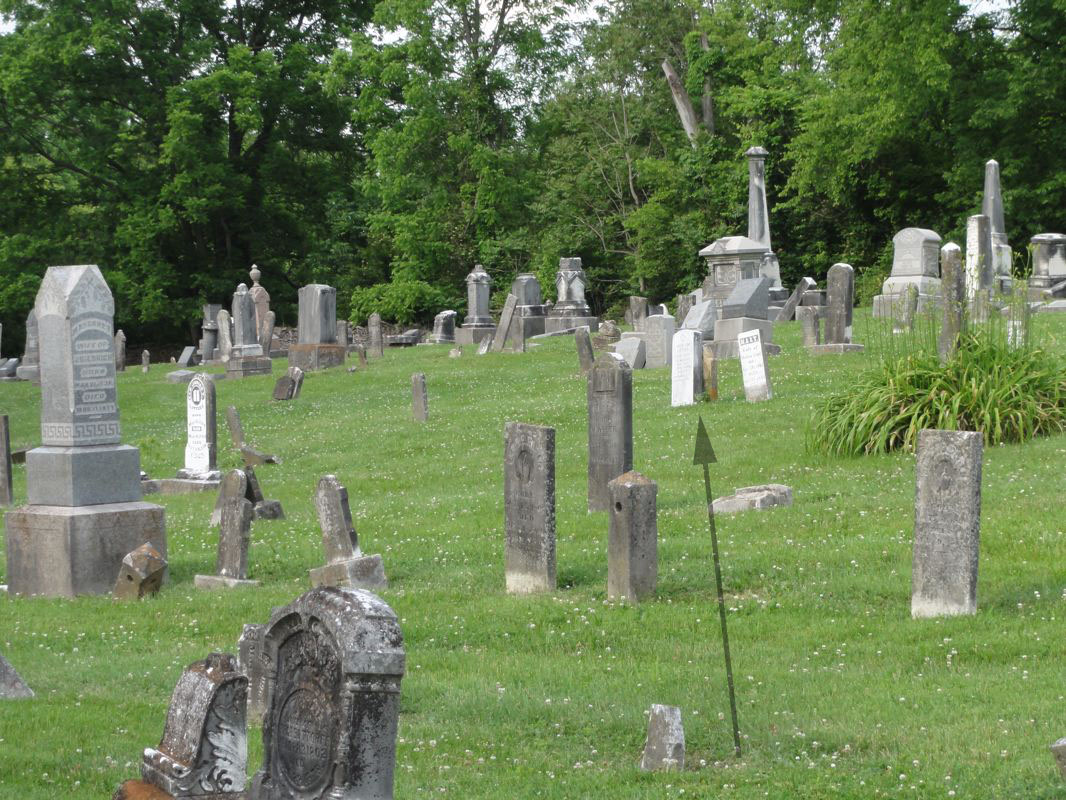Absalom Littell
1788-1862
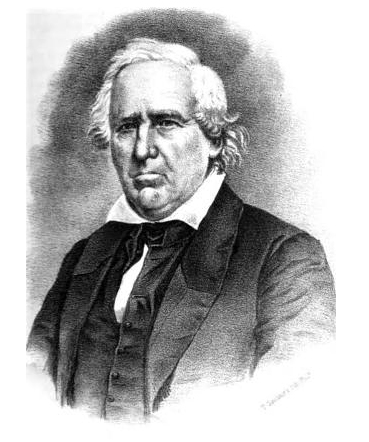
John T. Littell
1790-1848
![]()
Absalom And John T. Littell
The subjects of this sketch were both born in Fayette county, Pennsylvania—Absalom in the year 1788, and John T. in 1790. Their parents were poor, and both members of the Presbyterian Church.
In 1799 their father, Absalom Littell, who was a soldier in the Revolution, emigrated to what was then the far West, and settled on the west side of Silver creek, in Clark's grant, Northwestern Territory; or, in what is now Clark county, Indiana.
At that date there were but few "pale faces" in the Territory, and no settlements between them and the Rocky mountains, except a few French stations, or forts, containing a small number of Americans. The great West, that is now shaking the earth with its giant tread, was then in its infancy, eager for new ideas, and more susceptible than now of religious impressions. The influence of the Christian preacher in that day was, therefore, like that of the parent over the child.
Before the advent of the school-teacher to that part of the world, both Absalom and John T. had almost attained to their majority; hence they received but little instruction save that which was imparted in the domestic circle. Yet, by their own exertions, they became tolerably well informed; and of the Holy Scriptures especially they acquired a thorough and ready knowledge. Absalom, being more fond of literary and scientific pursuits, became the better scholar. He was well versed in parliamentary rules, and none was more frequently called to preside over religious meetings. Though his own life was regulated by the "perfect law of liberty," yet he had a respectable knowledge of the civil law; and his judgment in legal matters was as decisive as it was gratuitous. He peaceably settled many controversies between his neighbors, adjusting their differences with far more candor and fairness than a fee-hunting attorney would have done.
As there were no schools, so there were no churches. North of the Ohio river, and west of the Miami, not a single Protestant spire was to be seen. With a few exceptions there were no songs save the savage chant that led on the war-dance; no prayers, save those offered to the Great Spirit under the shadows of the tall oaks.
"Then was the time
For those whom wisdom and whom nature charm,
To soar above this little scene of things;
To tread low-thoughted vice beneath their feet;
To soothe the throbbing passions into peace;
And woo lone quiet in her silent walks."
It was not until the year 1798—a twelvemonth previous to the immigration of the Littells—that the first Protestant congregation was organized in Indiana Territory. This was a Regular Baptist church composed of four members, and established on the Philadelphia Confession of Faith.
The organization was effected a few miles northeast of the Littell settlement, but the first house of worship was subsequently erected on the east bank of Silver creek, near Mr. Littell's farm, where it became widely known as the Regular Baptist church at Silver creek. There it still stands, the oldest Protestant, and, perhaps, the first Reformed, church in the State.
Immigrants arriving constantly, brought with them their respective religious views, and it was not long until the people were favored with preaching by the representatives of the several leading sects.
Absalom Littell, sen., being an elder in the Presbyterian church, usually went with his family to that place of worship. Yet he was comparatively liberal in his views, and, in the absence of the Presbyterian minister, he attended, without partiality, the meetings of the various orders by which he was surrounded. By this means his sons acquired some knowledge of all the doctrines taught thereabout. Absalom was disposed to walk, if at all, in the steps of his father's faith, while John T. soon became much inclined toward the Baptists.
During the Indian troubles of 1811 and '12, Absalom and his eldest brother, Amos, served in the army of General Harrison; while John T. and others rendered no less important service as home-guards. Block-houses were built, sentinels posted, and every precaution taken to protect the women and children in the absence of their husbands and fathers. Amos was in the memorable battle of Tippecanoe, and Absalom was among the forces that marched to the relief of Fort Harrison, then in command of Lieutenant—afterwards President—Taylor.
The return of peace found them all alive; and, the weapons of war being cast aside, they turned their thoughts gratefully toward Him who had safely led them through so many dangers.
On the 27th of November, 1813, Amos united with the Baptist church and was immersed in Silver creek. On the 23d of July 1814, his example was followed by John T. Absalom, being at that time more disposed to see the world than to enter into the kingdom, travelled pretty extensively in Indiana, Kentucky, Ohio, Pennsylvania, and Virginia. He was present, however, at the baptism of John T.; but being greatly prejudiced against immersion, he stood afar off.
In the summer of 1816, John T. began to preach; and such was his natural ability that he very soon became a popular and most effective speaker.
Soon after his engaging in the work of the ministry, he removed to the muddy fork of Silver creek where he, with a few others from the old congregation, organized what is still known as the Muddy Pork church.
In April, 1815, Absalom, having become tired of rambling about, married, and settled down upon a small farm which he had acquired means to purchase.
Though he had been a young man of unexceptionable morals; and although he had been a member of the church from, his earliest infancy; yet, strange to say, he had never made a profession of religion! It was this very question of Infant Church-Membership, that caused him to linger so long without the door of the kingdom. In vain he read the Bible to find a firm support for the doctrine on which alone was suspended his hope of a glorious immortality. In vain he searched through subtle disquisitions on theology, in hope of finding a demonstration of the validity of Infant Baptism. No writer, either sacred or profane, satisfied him of the truth of that which he desired most of all to believe, namely, that baptism came in the room of circumcision. Loth as he was to abandon this popular tradition, he was compelled to do so after a careful re-examination of all the premises.
This stumbling-block being removed, he immediately went forward in the plain path of obedience, and, on the 27th of October, 1816, united with the Old Silver Creek Church, being immersed at the same spot at which, a few months before, he had witnessed, with so great mortification, the baptism of his younger brother.
At the first approach of the ensuing winter, the icy hand of death was laid upon his first-born. This sad dispensation, as it may have been designed, drove him nearer the cross. Observing that every thing beautiful goes down to the grave—that all things seen are temporal—he began to direct his mind to those things which are eternal. Anxious to devote his energies to the accomplishment of permanent results, he thought seriously of preaching; but, for a while, he was discouraged by the feeble efforts of illiterate preachers whose only excuse for their ignorance was the pretension that they were "called and sent."
On the 21st of the following April his wife also departed this life, leaving to his care a helpless babe.
This second affliction disarranged all his earthly plans. In a short time he removed from his farm to New Albany, where he engaged in mercantile business which proved to be very profitable. He also began to preach in the city and vicinity; and his first efforts were more acceptable than he had hoped.
In September, 1818, while passing through Washington county, he called by a house at the road-side to make some inquiries as to his route. A young lady, whom he had never seen before, having intelligently answered all his questions, he took his leave. On the 18th of the next November that same young lady, the daughter of John Martin, sen., was Mrs. Littell. He was not a man who halted long between two opinions respecting any matter.
Returning to New Albany, he continued to devote a portion of his time to the work of the ministry; and, in January, 1820, he assisted in the organization of the first Baptist (now Christian) church in that city. It seems that on this occasion he departed from some of the landmarks, regarded as sacred by his Baptist brethren. For, being appointed to write and convey a letter to the Blue River Association, asking for fellowship with the same, and appearing before that body, as directed, he was sharply questioned by those official guardians of the interests of Zion. After a solemn conference, the assembly asked him if he would, in the name of the church he represented, renounce its faith, as embodied in the letter which he had brought, and accept that of the Association as set forth in its Articles of Faith? This he refused to do, and the infant church at New Albany was, therefore, left to take care of itself. Such was the happy result produced by supreme devotion to creeds.
However, the little flock in New Albany steadily grew in number and in grace, visited as it was by several of the more liberal Baptist preachers; but most of all by John T. Littell, whose efforts on its behalf were unremitting.
On the 13th of June, 1820, a severe thunder-storm passed over the city. The house of Elder A. Littell was struck by lightning, by which his wife was felled to the floor, and his only surviving child, the last of his first family, was instantly killed.
This stroke of Divine Providence quite overcame him. The face of the Lord seemed to be against him. Perhaps— he thought—it was because he was not more completely devoted to his service. Therefore he closed out his stock in trade, and returned to his farm in Clark county; and from that time his labors were far more abundant, in the Lord.
The little congregation in New Albany was cordially received into the Silver Creek Association (formed in 1812) on the fourth Saturday of August, 1821. Then for a little season they all dwelled together in unity, and their Christian fellowship was "like the precious ointment upon the head."
From that date, Absalom and John T. Littell were the leading spirits in that portion of Indiana. Like Saul, the son of Kish, "from their shoulders and upward they were higher than any of the people."
For many years they annually, and by turns, wrote the "circular letter;" preached the "introductory sermon;" presided over the Association; and served that body in the capacity of scribe.
In the year 1826, the Baptists having been greatly multiplied, Elder A. Littell proposed the formation of a new Association. As chairman of a committee he reported a line of division; which was agreed to; and the new Association was accordingly formed.
A little subsequent to this, southeastern Indiana was liberally supplied with some pamphlets written by the Rev. Daniel Parker of Illinois, in support of what was called the “two-seed doctrine." For a while these documents created great excitement and drew away many disciples after them. Absalom Littell sought several opportunities of hearing Mr. Parker, who also travelled preaching—and having made himself well acquainted with the gentleman's position, and having examined well the different texts by which it was fortified, he determined to bring on an engagement, and if possible, drive the enemy from his intrenchments.
The parties soon met at Corydon, Indiana, at which place the Blue River Association had convened. It pleased the Assembly to select A. Littell, Daniel Parker, and a minister from Kentucky to fill the pulpit on Lord's day. The Kentuckian having spoken first, Elder Littell followed, basing his remarks upon Peter's declaration that "in every nation he that feareth him and worketh righteousness is accepted of him." With this and many other texts on his side, he felt that he went forth, like David, "in the name of the Lord of hosts;" and feeling thus, he dealt a heavy blow upon the two-seed Goliath.
The meeting was held in a grove; and just as he had concluded his sermon a shower of rain dispersed the multitude, and he was thus delivered from the shafts of his adversary. By this attack, however, he lost favor with many of his brethren, who had imbibed the two-seed doctrine.
About this time the light of the Reformation began to dawn upon that portion of the State. The terms “Campbellism" and "Campbellite" began to be heard frequently from the sacred desk, as well as in the family circle; and it was evident that a revolution in religious matters was near at hand. It was soon apparent, also, that hostilities were to commence in the old Silver Creek church—that there the first stone was to be cast at the old systems that were doomed to destruction.
Many of the brethren, as the eyes of their understand ing were opened, manifested less and less respect for the Articles of Faith, until the creed party, unable longer tr brook such contempt of the authority to which they bowed their willing necks, ventured to ask, in the public assembly, "What was the faith of this church when it was first organized?" By reference to the church record it was ascertained that it (the church) was established upon the Philadelphia Confession of Faith. Having given this plain hint as to the object to which all owed allegiance, the orthodox party permitted a brief season of rest. But seeing the joints of the old system opening wider and wider, they determined once more to tighten the screws.
To this end they proposed that submission to the Confession of Faith should be strictly regarded as a condition of fellowship. This proposition met with strong opposition, and disturbed the peace of the church for a long time.
Finally, a resolution was offered, demanding "to know from this church whether she is governed by the Old and New Testaments or by the Articles of Faith?" (Church Record.) This question, after a warm debate, was answered as follows: "The church say, by the word of God." (Church Record.)
This decision produced great excitement. Many of the more zealous opposers of reform left the church, but their places were soon filled; for the community, generally, approved of the action by which the seceders were so greatly offended.
Thus the Silver Creek church exchanged its human for the Divine creed. But Elders Littell and their coadjutors had not yet clean escaped from the thraldom of error. Though they had adopted the Bible as their rule of faith and practice, they were still subject to the rule of the Association; and they still adhered to many practices for which they could not have produced a “thus saith the Lord."
One would suppose that they would not have been long in being freed, if they did not free themselves, from the authority of the Association; for, under ordinary circumstances, that body would not have tolerated such an act, on the part of a congregation, as the open renouncement of the Confession of Faith. As it was, however, the Littells held the reins; and, by tho exercise of discretion and a spirit of forbearance and conciliation, they easily thwarted the efforts of all such as desired their excommunication. The subject was brought before the Association at its next session in New Albany; but the excitement passed away for that time without any serious consequences.
The exercises of that session were also enlivened by a revival of the two-seed theory. An aged brother from the Blue River Association being appointed to preach, began his discourse, very properly, with an apology for his ignorance, adding, for the encouragement of his hearers, that as the Lord would give to him so I could he give to them. He (or he and the Lord, as he would have people believe) then proceeded to elucidate the two-seed doctrine! His speech had a powerful effect on the large audience, so powerful, indeed, that it moved many into the streets and to their homes.
After it was all over, an old brother, whose speech betrayed the dialect as well as the penetration of the Yankee, observed, that “all preachers of that kind would soon die off, and that the Lord would make no more on 'em."
The prediction was in a measure verified; for from that time the favorite dogma of Elder Parker gradually waned, until it was no longer a matter of controversy.
For a few years subsequent to this, matters went on peaceably, being conducted in the spirit of compromise. The Baptists tolerated the abnormal views of those who were almost Reformers; and the Reformers, in turn, yielded to some of the peculiar views and practices of the Baptists. But each party became more and more positive in the advocacy of their respective tenets, until a final separation could no longer be averted. This took place first in the congregation at New Albany, in the year 1835; and soon afterwards in all the churches throughout that portion of the State.
The Reformers, in all cases, opposed division; and did all in their power to persuade their disquieted brethren to accept the word of God as their only rule of faith and practice. This the Baptists would not do; but, as soon as they found themselves in the minority, they chose rather to withdraw themselves, and have no further fellowship with what they regarded as “the unfruitful works of darkness."
With respect to those who continued in the “perfect law of liberty," the Association of 1835 was the last. From that time they held an Annual Meeting, not to form or amend constitutions; enact laws for the government of the church; or, in any way, to “lord it over God's heritage;" but to hear encouraging reports from the various churches; to worship the Lord in the "beauty of holiness;" and to consider how they might, most promote the interests of the Redeemer's kingdom.
Such was the introduction of primitive Christianity within the bounds of the old Silver Creek Association; and such was, briefly, the part taken by the Elders Littell in that important movement.
All the elements of discord having been eliminated, the disciples dwelt together in unity under the mild sceptre of the Prince of Peace; and, on every hand, they were greatly multiplied.
John T. Littell, with unflagging zeal, continued to evangelize for many years, baptizing a great number of disciples, of whom be kept no record. Among the number were eleven of his own children; and, since his decease, the remaining one has entered into the kingdom. Two of his sons—Milburn and John T., jr.—are successful preachers; and a third son—Maxwell—is an occasional laborer “in word and doctrine."
Returning indisposed from one of his tours, on the 11th of February, 1848, he observed to his family that he had filled his last outstanding appointment—a thing which he had not done before in thirty years. It was a singular fact, in view of the sad event which so suddenly followed. Always punctual in filling his appointments, it seems that even death itself was not permitted to infringe upon so good a habit.
Having taken some refreshments, he lay down before the fire to rest. In a few minutes he made a sudden effort to rise; rested a moment on his elbow; exclaimed "I am dying;" and almost instantly expired. Thus he illustrated the great truth which he had so often endeavored to enforce, namely, that “in the midst of life we are in death."
The following short extract is from his obituary notice, which appeared in the Christian Record for March, 1848:
"This good brother and affectionate elder has labored hard for his Lord and his numerous family for about forty years. I have thought that I never knew a man who loved the Bible more ardently than he. He has endured many hardships for the truth's sake. He plead the cause of the Bible alone in all matters of religion, and of the union of all Christians on the Bible, for some twenty years. But he has gone to 'rest from his labors; and his works do follow him.'"
Elder John Thompson Littell was a great man, physically, intellectually, morally. Had his mental been developed like his physical and moral powers, he would have been almost “perfect, thoroughly furnished unto all good works." His stature exceeded six feet; and his weight was more than two hundred pounds. He had dark hair; a large, well-shaped head; keen, blue, speaking eyes; a prominent nose; a mouth that seemed made for noble speech; and a broad, open face, expressive of every quick sensation.
He was a natural orator—clear in argument; powerful in exhortation; in manner positive, if not dogmatical. Education was all he lacked to make his name as familiar to the nation as it was to the little circle in which he lived, moved, and died. He was of a gentle and affectionate spirit, full of vivacity and most excellent humor. Seventy times seven, if his brother sinned against him, seventy times seven could he forgive him, on the legitimate condition of repentance. This trait of his character, as well as the severe and peculiar manner in which he sometimes put to shame the enemies of truth, was clearly exhibited in an incident which certainly occurred at or near Salem.
He was preaching to a large congregation in the presence of a certain minister whose name and order shall be mercifully concealed. In discussing some point relative to Baptism, he made a quotation from Wesley's Doctrinal Tracts, remarking—as if fearful he had not given it verbatim—that if he had not quoted fairly he hoped he might be corrected. The unsuspecting preacher instantly cried out, “I unhesitatingly affirm that the passage does not read that way." “Well, well," said Elder Littell, with the greatest sangfroid, “we will read it as it is." Suiting the action to the word, he drew from his pocket a copy of the "Tracts;" and read the passage which, as he knew very well, was precisely as he had quoted it. Nothing daunted, the preacher took the book; and gave the audience a different reading. At the request of Elder Littell a small boy then came forward; and again read the passage as it was. This settled the controversy; and the discourse was resumed as if nothing had happened.
When the speaker concluded, the convicted preacher asked leave to make a few remarks. Being politely assured that he should have perfect liberty, he arose and spoke substantially as follows:—”I confess," said he, “that, under the excitement of the moment and the bad feeling that then possessed me, I read the passage wrong; and I pray God to forgive me." "amen," said Elder Littell; and those who knew him did not doubt that the response came from the bottom of his heart.
Though on all occasions he occupied a conspicuous place among his brethren; yet he never thrust himself into the highest seat; but was always meek and unassuming.
Living in a controversial age, he was, necessarily, somewhat doctrinal; but, in the main, his discourses were eminently practical. When the occasion demanded it, he could wield the sword of the Spirit with a strong and skillful hand; but he was more inclined to provoke his brethren to love and to good works; and most successful in persuading sinners to lay hold on the hope which he eloquently set before them. Christianity in practice, was the great object for which he strove.
Like all other men he doubtless had his faults; but in most things he might well have said to his brethren, "be ye followers of me;" for he followed Christ. But
“No further seek his merits to disclose,
Or draw his frailties from their dread abode—
There they alike in trembling hope repose—
The bosom of his father and his God."
After the death of John T., his brother Absalom continued to labor in the gospel as in former years. Finally, however, the infirmities of advancing age compelled him to economize his strength; and during the last years of his life he accomplished comparatively but little in the work of the ministry. Yet the spirit was willing; though the flesh was weak. The sickle was still keen as ever; but the power that wielded it was failing.
The nearer he approached the grave the more ardently he desired the steadfastness of the disciples; and among the last words he ever wrote, were the following addressed to his “dear brethren."
“Permit an old brother in the 74th year of his age, to say to his younger brethren, and to all: Suffer no strife to rise up among you. Abstain from all appearance of evil. And the very God of peace sanctify you wholly; and I pray God your whole spirit and soul and body be preserved blameless unto the coming of our Lord Jesus Christ,"
On the 11th of May, 1862, at 9 o'clock, P. M., he breathed his last. Conscious of his approaching dissolution, he assured those present that death had no terrors; and that he "died only to live." His remains were followed by a long procession to their resting place, in the quiet old church-yard near Hamburg, where they await, in peace, the “voice of the archangel and the trump of God."
In appearance and character, Elder Absalom Littell was much like his brother, John T. Born of the same parents rocked in the same cradle; hushed by the same lullabies sent to the same schools; baptized in the same stream and preachers of the same gospel, which changes men into the same image; they could not well be so dissimilar as to afford materials for two separate and distinct sketches.
Absalom was, however, somewhat larger than his brother; and he was regarded by many as correspondingly superior in point of intellect. But the difference of ability was rather the result of education than of any partiality on the part of nature.
As an orator he was inferior, though he spoke readily, forcibly, and to the point. Their sermons were similar in character; and were usually directed to the same end.
Absalom always conducted himself with gravity becoming his office; yet he too was most richly endowed with the faculty of wit, and with that cheerful disposition which "doeth good like a medicine." In a little circle of old friends, he was as agreeable as he was happy.
In the church and before the world, they manifested the same spirit; for both had "the spirit of Christ."
Such were those two distinguished pioneers; and such the part they acted in establishing the “ancient order of things" in the commonwealth of Indiana. It is necessary to add only two borrowed lines, expressive, no doubt, of the feeling with which every Christian reader will reach the end of this brief and imperfect sketch:
"Those suns are set,
O rise some other such."
-Madison Evans, Biographical Sketches of Pioneer Preachers In Indiana, 1862, J. Challen & Sons, Philadelphia, PA, pages 42-56.
![]()
Location of the Graves Of Absalom Littell & Info On Whereabouts of John T. Littell
According the Madison Evans the Littells were buried at the old church-yard at Hamburg. Well, the Hamburg church is gone. It appears from recent information that has come to light, Absalom Littell is buried in the Silver Creek Cemetery near Sellersburg, Indiana. Also, John Thompson Littell died at Washington, Indiana, the 11th of February, 1848. It is assumed that he may be buried there. There are a number of Littells at Silver Creek Cemetery, but John T. is not in the list on Find-A-Grave.com. See Find-A-Grave.
In Sellersburg, in southern Indiana, take I-65 to Exit 9, and head NE through town. Take Hwy 31 north out of town, and go three or four miles. Turn right on Perry Crossing Road, also known at Bud Prather Road. It will dead end. Turn right, noting that the road is still Bud Prather Road. You will cross a creek and bear around to your left on Brick Church Rd. Go up past the old brick church on your left, up the hill and enter the cemetery on your left. It may be locked and you have to walk in. Once inside, go back down to the back of the old brick church and head toward the rear of the cemetery below the church. It is a little over half way to the end of the cemetery that you will begin seeing Littell family plots. Absalam will be buried in the oldest grave in the family plot, although there are quite a few old ones there. The GPS below pinpoints Absalam Littell's grave with accuracy.
GPS Location
38°26'25.7"N 85°44'41.6"W
or D.d. 38.440482, -85.744892
![]()
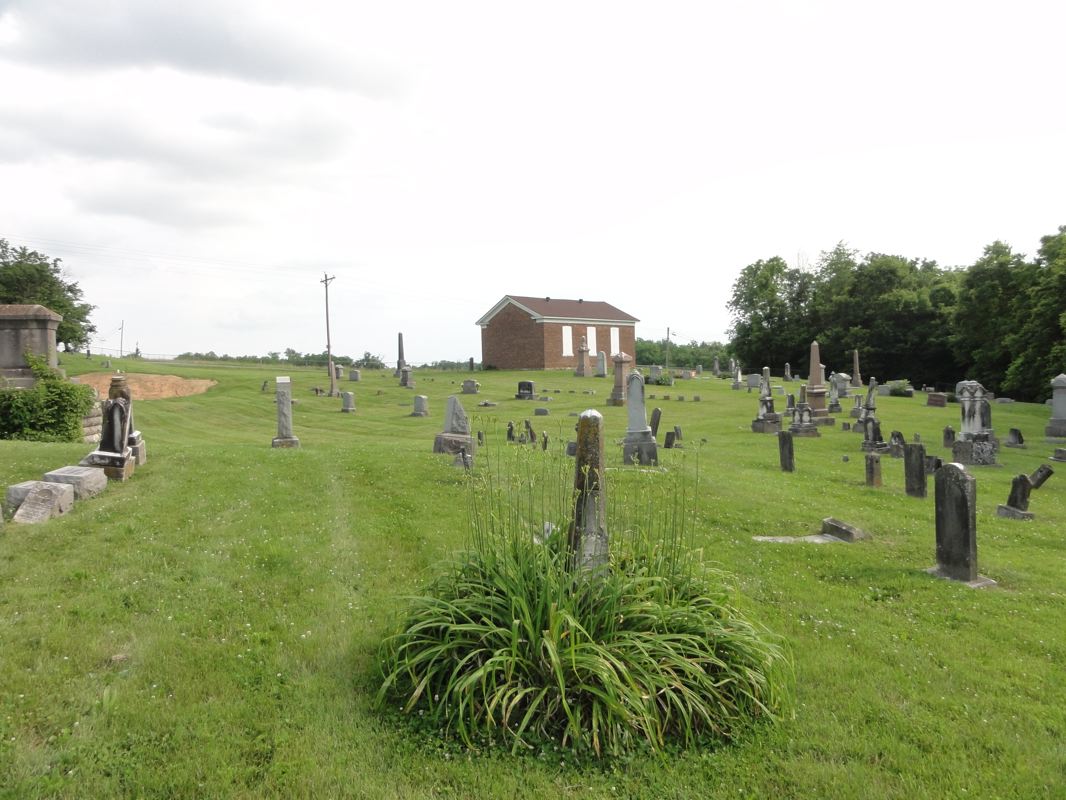
Looking Back Toward Old Baptist Church Building
![]()
Special Thanks
Photos Taken May 21, 2012
Courtesy of Scott Harp
www.TheRestorationMovement.com
Web Editor's Note: On May 21, 2012 I visited the grave of Absolam Littell. I had just begun a week's Restoration Research trip with my dear friend Tom L. Childers. Absalom Littell's grave was early on our list of preacher's graves to be found. While visiting the cemetery, the old caretaker came up to see who was visiting his graveyard. A very pleasant chap, he was an older man, and it was difficult to catch all his words. We asked if he knew anything about the Littells. He said he did. And, proceeded to tell how the Littells had split the Baptist church years ago, and took it from the Baptists for a time, but later the Baptists returned to take over the old building. It was a pleasure for Tom and I both to visit the graves of some of the oldest members of the churches of Christ in the early to mid 1800s.
![]()
